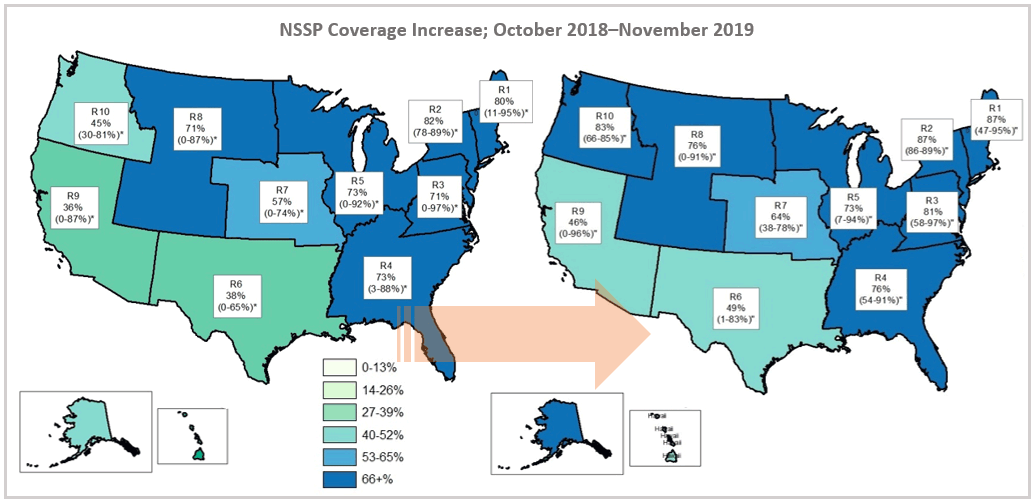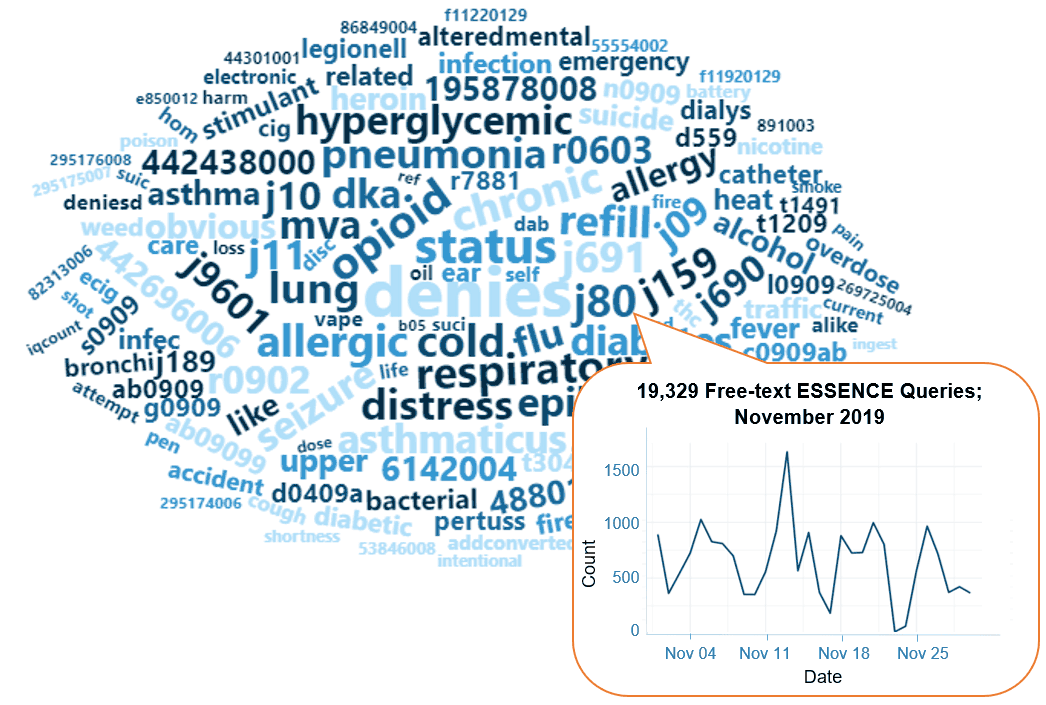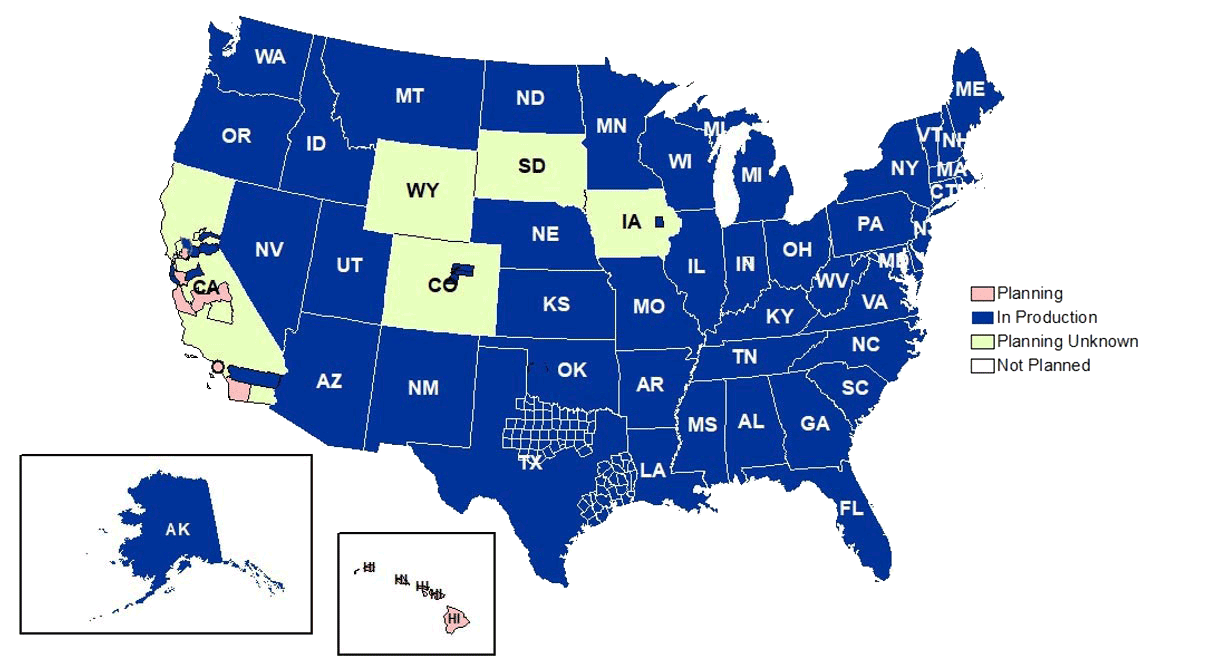NSSP Update – January 2020

January 2020
Community of Practice
Community of Practice
We must always do our best to stay ahead of challenges.

2020 Message from the Program Manager, NSSP
Last year I described our continued growth and shift in trajectory—slowing down new development to maintain the integrity of what we have built. While that was a large part of our activity in 2019, we still found opportunities to grow and do more.
NSSP participation expanded to 59 sites, encompassing all or some portion of 47 states and the District of Columbia. NSSP data now represent about 70% of U.S. emergency department (ED) visits, a 6% increase from last year’s 64%! And that isn’t all. Regional coverage continues to improve (see graphic).
NSSP’s expansion of coverage can be attributed to the hard work of highly motivated and engaged community members and to NSSP’s onboarding efforts. CDC’s Epidemiology and Laboratory Capacity for Infectious Diseases Notice of Funding Opportunity (NOFO), Crisis NOFO, and OD2A NOFO also made an impact, with subsequent funding being used to expand state and local capacity to conduct syndromic surveillance.

The NSSP Community of Practice (CoP) drove improvements in data coverage, data quality, and data sharing—all of which have a critical impact on program participation. In 2020, we expect three more sites to join us: Hawaii, South Dakota, and Los Angeles. This will increase state coverage to 49, most likely improving estimated ED visits as well.
And the progress doesn’t stop here. In 2019, NSSP—
- transitioned the NSSP CoP to the Council of State and Territorial Epidemiologists.
- transitioned the in-house cooperative agreement funding mechanism to a flexible Epidemiology and Laboratory Capacity NOFO.
- hosted data-sharing workshops around the country, culminating in a capstone meeting to examine lessons learned from workshops.
- deployed a new look and feel to the Access & Management Center, correcting an error associated with sharing data subsets, accompanied by process and performance improvements. This release positions us for more granular control of data sharing.
- deployed the data quality dashboard.
- deployed a new version of ESSENCE with many new features like shared dashboard templates, time series graphs that depict data quality, and n-gram text analysis.
This brings us to surveillance. NSSP surveillance capability and capacity have surged. This might not be readily apparent to health department partners outside CDC. But in today’s environment, collaborations that find new uses for syndromic data or integrate it more fully with traditional surveillance methods are essential for program growth and funding.
In 2019, NSSP—
- supported hurricane response efforts;
- continued to support opioid overdose surveillance efforts;
- began to support suicide attempt and suicide ideation surveillance;
- developed and deployed many CCDD categories;
- engaged several CDC programs to launch new projects;
- explored new text and statistical methods;
- explored machine-learning methods;
- evaluated ways to improve ESSENCE alerts; and
- responded to e-cigarette, or vaping, product use-associated lung injury (EVALI).
These are just a few examples. The EVALI work alone garnered national attention and put syndromic surveillance front and center during CDC response efforts in ways it hasn’t been before.
So, what can we expect in 2020? Our growth strategy is to further improve system performance. The NSSP development team is exploring ways to integrate death data into the BioSense Platform, and we continue to work toward making lab data available.
We plan to make architectural changes a major area of focus in 2020. As we integrate more data into the BioSense Platform and add users and use cases, the system will be expected to perform reliably AND achieve more than before. That’s why we must always do our best to stay ahead of challenges—across all of our operations—and be poised for growth within the budget we have.
NSSP will introduce data sharing by syndrome. We will also work with community surveillance experts to refocus efforts by following up on activities suggested in the data-sharing workshops.
It goes without saying that even with foresight and planning, we could still potentially face unforeseen challenges related to disease or events of public health concern. Be assured, the NSSP team and the analysts, epidemiologists, and other public health specialists who make up the NSSP CoP stand ready to take on a new year.
Here’s to 2020 and continued NSSP success!
Sincerely,
Michael A. Coletta, MPH
Cultivate Success by Joining the NSSP Community of Practice
The NSSP CoP is all about collaboration. By joining, you’ll tap into an established mechanism for receiving technical assistance on all topics related to syndromic surveillance. Here are some links for the NSSP CoP you’ll want to bookmark:
- Streamlined Workflow for Data Access Rules
- Enhancements to Data Sharing
- Downloadable Data Access Rules for Offline Review
- Improved SQL Architecture Aligns Data Access Rules with ESSENCE Capabilities

- Knowledge Repository: https://knowledgerepository.syndromicsurveillance.org/
Curated webinars, use cases, syndromes, stories of surveillance in action, meeting recordings, journal articles, and more - NSSP Community of Practice Landing Page: https://nsspcommunityofpractice.org/
CoP overview, description of workgroups and committees, call calendar, and links to NSSP resources - Content Submittals (syndromes, success stories, postings): syndromic@cste.org
- NSSP CoP Basecamp: https://3.basecamp.com/3164497/join/MxRBAPzoNn8M
Coming soon! Online collaborative space for the NSSP CoP and its committees that includes call recordings, slides, and brief notes from committee meetings
ESSENCE Queries: November 2019

A key feature of NSSP–ESSENCE is its ability to use free-text definitions across different fields to generate custom queries. The syndromic surveillance community can use this feature to develop and refine category definitions and to identify and respond to public health events that may not be apparent in established categorical definitions (i.e., syndromes, subsyndromes, and Chief Complaint and Discharge Diagnosis [CCDD] categories).
This word cloud summarizes free-text and coded values that epidemiologists and data analysts queried in ESSENCE during November 2019. We created it by using the Wordcloud2 package in RStudio. The relative size of the terms suggests the frequency of use in a query. NSSP super administrators can query ESSENCE usage logs to learn what queries are run nationwide and how long they take to complete.
Collaborations
Collaborations Accelerate Syndromic Surveillance Practice

Collaborations between health departments and CDC programs are improving how syndromic surveillance gets done. The list of collaborations that follows, while not exhaustive, summarizes ongoing efforts to develop and improve syndrome definitions, conduct pilot tests and exercises, and improve processes to achieve public health goals more efficiently:
- Develop syndrome definition for marijuana v3.
- Collaborator: Opioid and Overdose Team
- JUST RELEASED! Check out the syndrome in ESSENCE.
- Develop syndrome definition for pregnancy, delivery, and miscarriage.
- Collaborator: CDC’s Maternal and Infant Health/Maternal and Infant Health Branch
- Develop syndrome definition for injecting drug users and endocarditis (infection of inner lining of heart chamber and valves).
- Collaborator: CDC’s National Center for Emerging and Zoonotic Infectious Diseases, Epidemiology Research and Innovations Branch
- Develop syndrome definition for e-scooter-related injuries. NSSP is part of the Transportation Safety Team’s e-scooter working group.
- Collaborator: CDC’s Division of Unintentional Injury Prevention and the Transportation Safety Team
- Develop syndrome definition for motor vehicle collision syndrome.
- Collaborator: CDC’s Division of Unintentional Injury Prevention and the Transportation Safety Team

- Develop syndrome definition for child abuse and neglect.
- Collaborator: CDC’s Division of Violence Prevention
- Develop syndrome definition for child sexual abuse.
- Collaborator: CDC’s Division of Violence Prevention
- Develop syndrome definition for sex trafficking.
- Collaborator: CDC’s Division of Violence Prevention
- Develop syndrome definition for teen dating violence.
- Collaborator: CDC’s Division of Violence Prevention
- Develop syndrome definition for homeless populations.
- Collaborator: CDC’s Division of Violence Prevention
- Develop syndrome definition for animal bites.
- Collaborator: CDC’s National Center for Environmental Health
- Develop syndrome definition for synthetic marijuana.
- Collaborator: CDC’s Opioid and Overdose Team
- Update syndrome definition for Influenza-like Illness (ILI) CCDD category.
- Collaborator: CDC’s Influenza Division
- Develop strategies to capture radiation exposures following a radiation disaster and examine how syndromic data can be used to supplement existing radiation exposure surveillance using poison control center data.
- Collaborator: CDC’s National Center for Environmental Health
- Assess whether snake bites increase after natural disasters and if data from NSSP and poison control centers can be incorporated to analyze snake bite incidence pre- and post-disaster.
- Collaborator: CDC’s National Center for Environmental Health
- Participate in a functional exercise to gauge how well the community shares information and data during a public health event. This exercise will evaluate response speed; technical needs and delivery options; potential local, state, and federal collaborations; and integration of emergency preparedness and management personnel.
- Collaborator: NSSP CoP Syndromic Surveillance and Public Health Emergency Preparedness Response and Recovery Committee
- Work on a special-interest project though the Prevention Research Centers Program: “Improving Cancer Survivor Treatment and Outcomes by Ensuring Appropriate Emergency/Acute Care Treatment.” Work began fall 2019 and will extend through 2020.
- Collaborator: CDC’s National Center for Chronic Disease Prevention and Health Promotion, Division of Cancer Prevention and Control
The dates listed are approximations and can change. Our thanks to Health Scientist Nimi Idaikkadar (Center for Surveillance, Epidemiology, and Laboratory Services; Division of Health Informatics and Surveillance) for this update.
Data Quality Corner
5 Simple Tips for Improving Query Performance
Running complex or multiyear queries without adversely affecting other ESSENCE users can be challenging, even for power users. Here are some general tips for queries that will help ESSENCE run quickly and efficiently for all users.
- Let the query run completely before you start making changes. Often in the process of running or testing a query, small changes need to be made, usually resulting in an attempt to cancel the query and rerun an updated one. Unfortunately, even after you close the browser window, hit the cancel or refresh button in your browser, or cancel the Application Programming Interface (API) request, the original query will continue to run to completion in the database. Browser actions do not cancel queries already sent to the database. This means that multiple queries that are similar can be running at the same time on ESSENCE. A good rule of thumb is to wait until you see data before refreshing and resubmitting—otherwise, you might encounter the browser’s nonstop spinning wheel. In other words, avoid submitting the same query multiple times.
- Run ONE free-text query at a time. When you’re working with large datasets that span multiple years, although it might seem quick and efficient to run multiple queries in parallel, it’s not. The more requests the server receives, the more time all query requests take to run. Instead, try running requests sequentially. That’ll lead to better performance. Always avoid running multiple free-text queries at the same time.
- Use short time parameters to test free-text queries. When fine-tuning a free-text query, a large time range is rarely necessary to get a sense of the query results. We recommend using 3 to 6 months’ data from the Chief Complaint Query Validation (CCQV) data source. If you are analyzing a rare health event or seasonal effects, try running the same query multiple times over different 3- to 6-month periods.
- Run multiyear trends of free-text or complex queries when there’s less traffic. If you want to identify the multiyear trend of a free-text query or a complex query with many filters, try running the query either early in the morning or late in the afternoon when fewer analysts are using ESSENCE. Or, consider turning the free-text queries that you perform routinely into Chief Complaint Discharge Diagnosis (CCDD) Categories in NSSP–ESSENCE, which should speed up performance dramatically. Please contact us if you have a query you would like us to convert to a CCDD Category.
- Use the ESSENCE API. If you need to analyze a free-text query over multiple years using methods outside ESSENCE, break down your request into smaller chunks of time—for example, into 3- to 6-month intervals—and then combine these to form one large dataset. In short, avoid running one multiyear free-text query using the APIs in favor of multiple queries broken up into time increments.
The NSSP team routinely monitors system performance and assesses system architecture to keep up with demand. If you have questions or want to modify your workflow to keep ESSENCE running efficiently, please contact us. We will tailor additional guidance based on your analysis needs.
Technical Updates
For Best Performance, Start Using Chrome
After the December release of the Access & Management Center (AMC) version 1.5.1, the AMC will no longer be updated to support Internet Explorer. For best performance, please use Chrome for the AMC and ESSENCE applications.
Current Month and Upcoming Events
| January 21 | NSSP Community of Practice Call |
| January 21 | Make vendor patches in onboarding and production environments: 6:00–10:00 AM ET |
| January 23 | Make vendor patches in testing and development environments: 6:00–10:00 AM ET |
Last Month’s Technical Assistance
| December 3 | Deployed AMC v1.5.1 to Onboarding (Staging) system |
| December 5 | Deployed AMC v1.5.1 to Production system |
| December 19 | Made vendor patches in staging and production environments |
NSSP Participation and Coverage
Participation: The map below shows participation in NSSP as of September 2019, with 59 sites (47 states and the District of Columbia).

Definitions: NSSP consolidates facilities that provide data under a single data administrative authority called a site administrator. These facilities and single-site administrator constitute a site.
Coverage: NSSP publishes data for emergency department (ED) visit coverage each quarter. As of September 30, 2019, data from EDs covered about 70% of all ED visits in the country. There were 4,657 facilities, including 3,119 emergency EDs from 59 sites (47 states and the District of Columbia), actively contributing data to the NSSP BioSense Platform. The calculation method is described in the December 2018 issue of NSSP Update.
